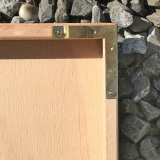- Original paintings
- >
- Springy
Springy
Original encaustic* painting.
Size: 40/40 cm
A certificate of authenticity signed by the artist is provided at purchase.
Realized on wooded panel with hanging attachement already installed (see detail photo).
*The word encaustic originates from the Greek word enkaustikos which means to burn in, and this element of heat is necessary for a painting to be called encaustic. It involves using heated beeswax to which colored pigments are added. The liquid or paste is then applied to a surface—usually prepared wood, though canvas and other materials are often used. The simplest encaustic mixture can be made from adding pigments to beeswax, but there are several other recipes that can be used—some containing other types of waxes, damar resin, linseed oil, or other ingredients. Pure, powdered pigments can be used, though some mixtures use oil paints or other forms of pigment
This technique was notably used in the Fayum mummy portraits from Egypt around 100–300 AD, in the Blachernitissa and other early icons, as well as in many works of 20th-century North American artists, including Jasper Johns, Tony Scherman, Mark Perlman, and Fernando Leal Audirac. Kut-kut, a lost art of the Philippines, employs sgraffito and encaustic techniques. It was practiced by the indigenous tribe of Samar island around 1600 to 1800. Artists in the Mexican muralism movement, such as Diego Rivera and Jean Charlot sometimes used encaustic painting. The Belgian artist James Ensor also experimented with encaustic.



